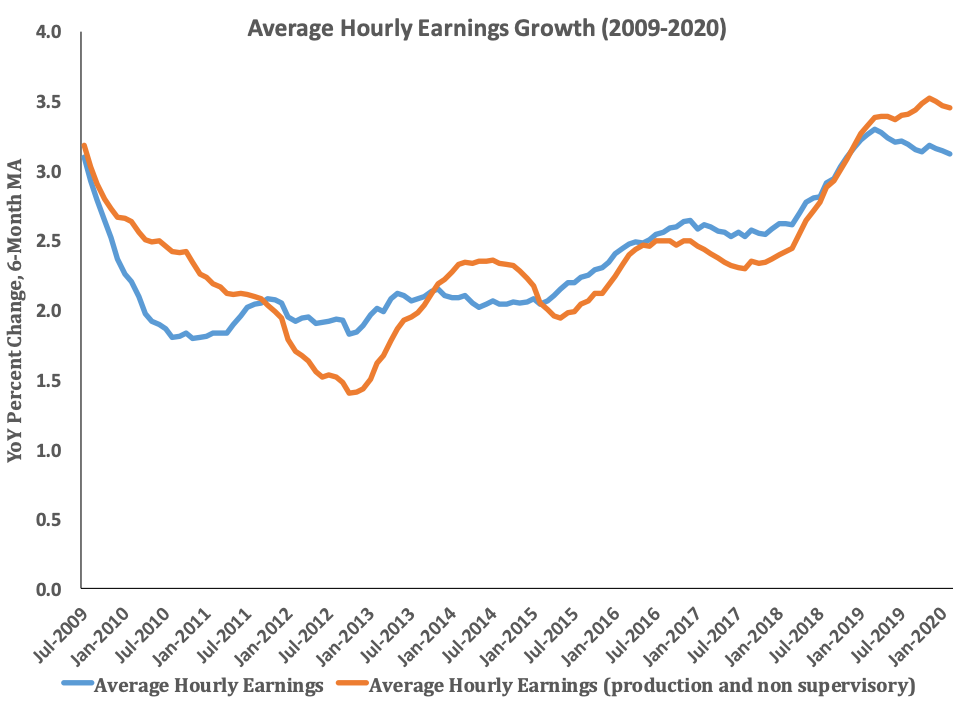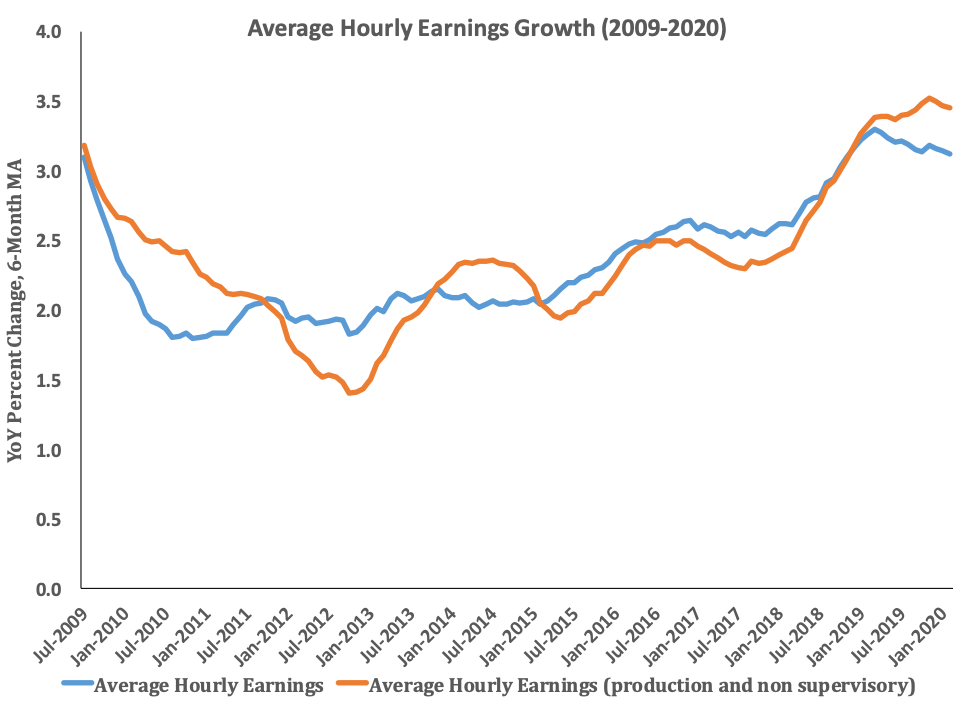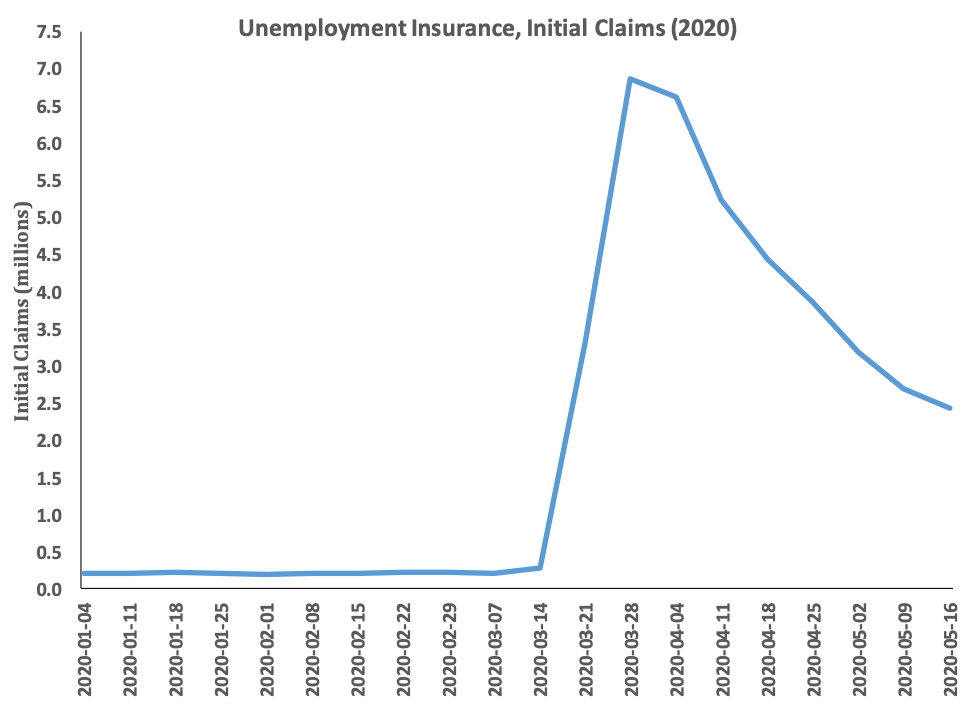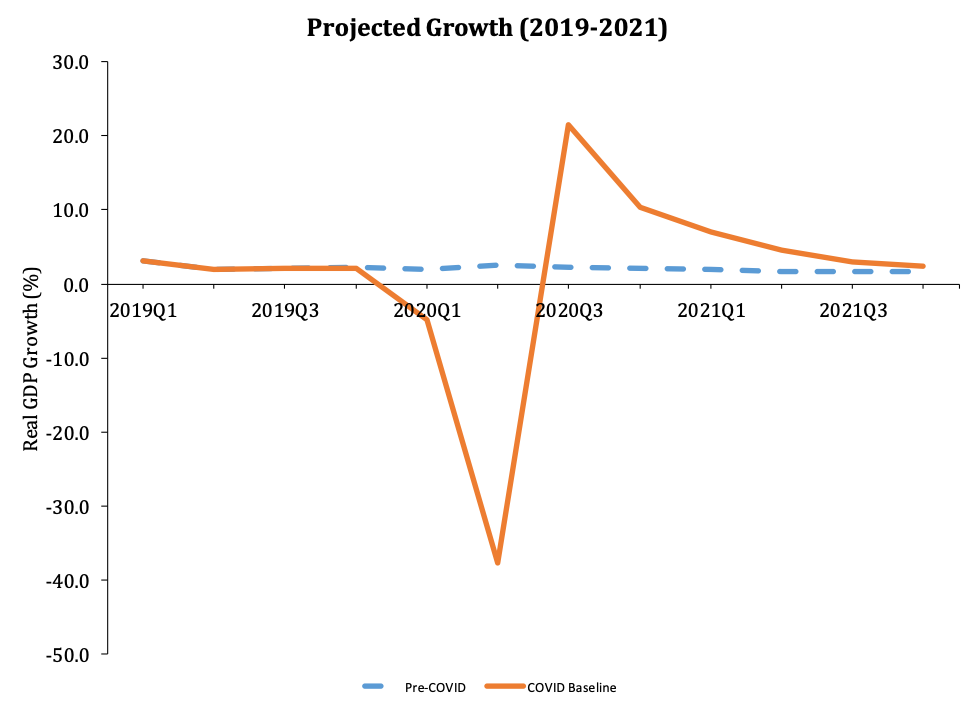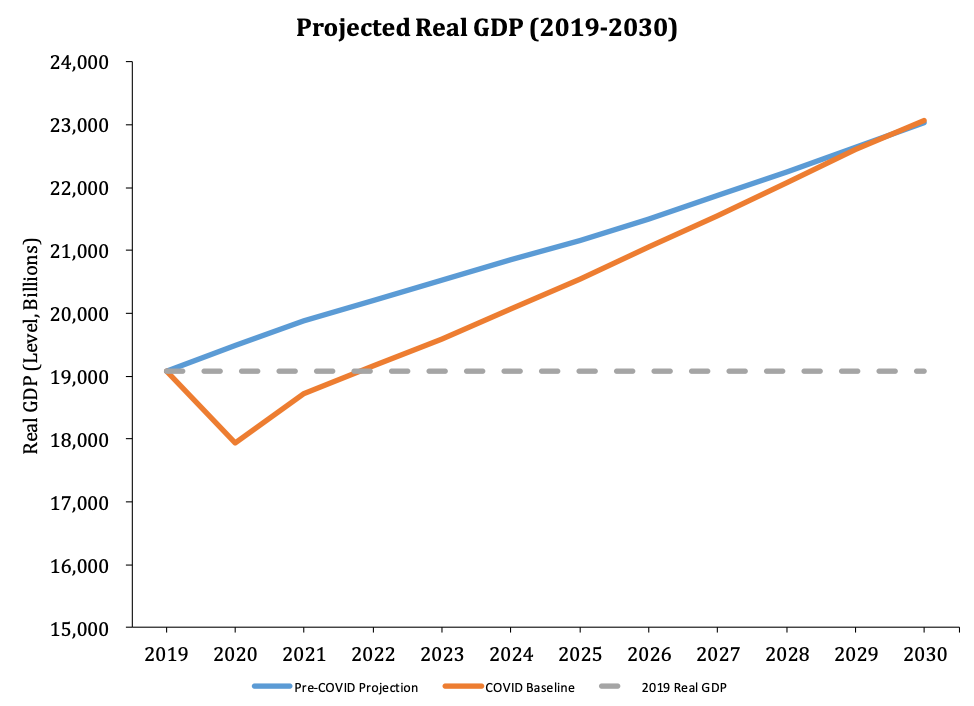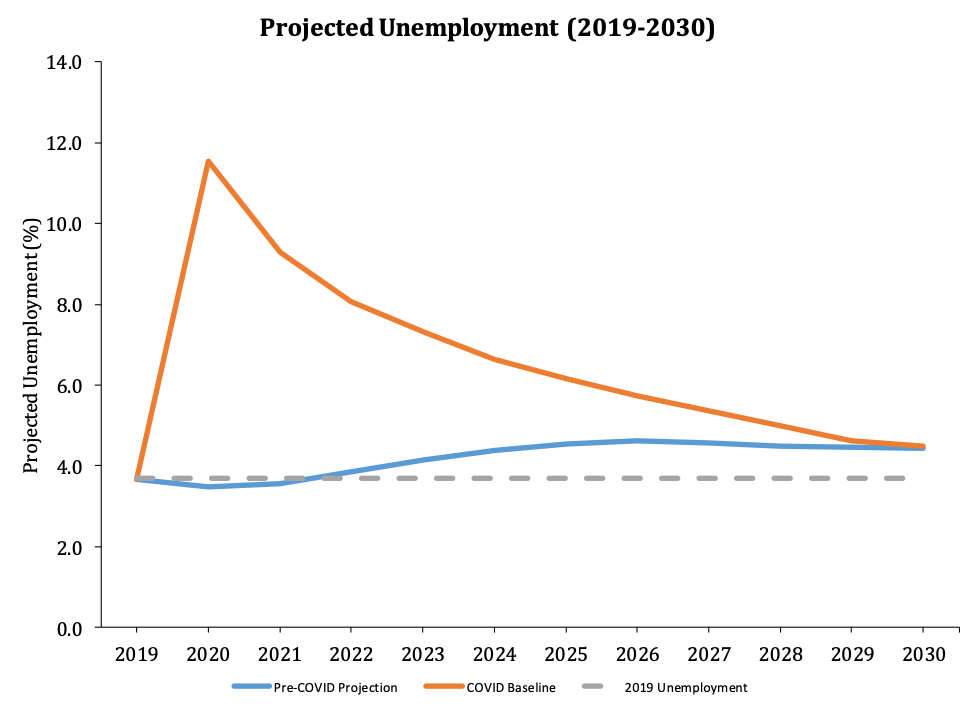Testimony
June 3, 2020
Addressing the Economic Impacts of COVID-19
United States House of Representatives Committee on the Budget
*The views expressed here are my own and not those of the American Action Forum. I thank Gordon Gray and Thomas Wade for their insight and assistance.
Chairman Yarmuth, Ranking Member Womack, and members of the Committee, thank you for the privilege of appearing today to share my views on the economic and budgetary impact of the COVID-19 pandemic and the policy response to its impact. I wish to make three main points:
- The economic fallout of the pandemic is staggering and unprecedented in our lifetimes;
- The policy response has been, of necessity, correspondingly large and well-targeted to address the economic problem; and
- Looking forward, Congress faces the challenge of maintaining a disciplined response while shifting strategies to support growth and economic progress in the presence of the coronavirus.
Let me discuss these in turn.
The Impact of the COVID-19 Pandemic on the Economy
The macroeconomic impact of the COVID-19 pandemic far exceeds any experience in our lifetimes. Essentially all the major leading economic indicators have seen historic declines, wiping out the hard-won gains from the longest recovery in U.S. history.
Recent Economic Trends
Prior to the pandemic, there had been a meaningful improvement in the persistence of healthy economic growth over the past three years. Gross domestic product (GDP) growth, measured as the growth from the same quarter in the previous year, accelerated steadily from a low of 1.3 percent in the 2nd quarter of 2106 to a recent peak of 3.2 percent in the 2nd quarter of 2018. Of note, throughout this period GDP growth remained above the 1.8 percent growth rate that prevailed throughout the balance of the recovery.
In June of 2009, the United States began the economic recovery from the Great Recession. What followed was nearly 11 years – the longest expansion in U.S. history – of steady if modest economic growth. Over that period, nearly 22 million jobs were created. Remarkably, the pace of job creation accelerated over the course of the recovery. Over the first half of the recovery, monthly job creation averaged 138,000; this increased to 198,000 new jobs created per month over the latter half of the recovery.
With higher growth and tighter labor markets, unemployment continued to fall as payroll and wage growth accelerated. Wage growth improved for all workers, including for non-supervisory workers. Indeed, from December 2018 onward, growth in hourly earnings (on a yearly moving average) for production and nonsupervisory workers outpaced that of workers overall every month.
The economic story of the recent past is the realization of years of modest growth finally beginning to accrue to individuals and families, broadly raising the standard of living. Recent accelerations in that growth punctuated a return to prosperity. That all came apart in March of 2020.
The Economic Impact of the COVID-19 Pandemic
The COVID-19 pandemic precipitated a historic shuttering of the economy in March, guaranteeing that the broadest measure of economic wellbeing – real quarterly GDP growth – would reflect some of the devastation in the first quarter. Indeed, the Bureau of Economic Analysis’s (BEA) estimate for the decline in first quarter GDP is 5.0 percent on an annualized basis. This is the single largest drop in real GDP since 2008. While any contraction, particularly one on the order of magnitude with those observed during the Great Recession is troubling, in this instance, the contraction reflects only the leading edge of the economic devastation.
Higher frequency data reveal a historically devasted economy. Payrolls in April fell by 20.5 million, with private sector payrolls shedding 19.5 million jobs. The service sector lost over 17 million jobs. The leisure and hospitality industry was particularly devastated, losing over 7.6 million jobs. Goods-producing industries saw a decline of over 2 million. Government shed 980,000 jobs. No industry saw net positive hiring.
The unemployment rate jumped to 14.7 percent, which exceeds the highest level since the Great Depression. As BLS notes, were it not for the classification of some workers as employed but “Absent for other reasons,” this number would be on the order of 5 percentage points higher.
More frequent data still – weekly unemployment insurance (UI) claims – tell a similar story. Before March of this year, the single highest weekly initial claims report was 695,000 in 1982. No week in recorded U.S. history saw millions of Americans claiming unemployment insurance benefits. In the present environment, new UI claimants can only be measured in the millions.
In short, April job losses are 10 times larger than any previous month’s job losses. The April rise in the unemployment rate is 10 times larger than the previous one month increase. The 6 million new claims for unemployment insurance in one week is 10 times larger than the previous one-week increase. The outlook for the 2nd quarter of 2020 is that GDP will decline by 11 percent; in the worst year (1932) of the Great Depression, the decline was 12 percent. The U.S. economy is enveloped in an economic downdraft of unprecedented magnitude.
The Policy Response
In light of the size of the problem, it is appropriate that the policy response has been unprecedentedly large as well. In addition, the mechanism of the downturn differs significantly from earlier episodes such as the Great Recession or Great Depresssion; this dictates a different character to the policy response.
At the onset, the U.S. economy suffered from massive, cascading cash-flow crunches. With the arrival of the virus, large swaths of the economy – airlines, hotels, entertainment, restaurants, and so forth – overnight lost their customers and revenue. Businesses and households started selling everything they could to raise cash and hang on. The mass sell-off buffeted financial markets. The Federal Reserve (Fed) has done a sterling job of minimizing the turbulence. It reduced its policy rate to zero and announced an open-ended, unlimited buying spree. As the Fed put it, “The Federal Open Market Committee (FOMC) will purchase Treasury securities and agency mortgage-backed securities in the amounts needed to support smooth market functioning and effective transmission of monetary policy to broader financial conditions and the economy” (emphasis added).
The Fed revived two programs from the financial crisis and created two new facilities to extend credit to large employers via the purchase of corporate debt (see Table 1). It also revived an emergency lending vehicle last used in the 2007-08 crisis to support small businesses and consumers by encouraging investors to buy securitized student debt, auto debt, and credit-card debt.
These actions were effective in restoring normal function to financial markets and prevented an economic crisis in the real, Main Street economy from transforming into a financial crisis as well. As part of this effort, the Fed set up a variety of emergency lending facilities for financial market participants. Banks, in particular, and financial markets, in general, continue to perform effectively.
Table 1 – Federal Reserve Emergency Lending Facilities
Source: The American Action Forum
But not everyone could raise enough cash selling assets. Instead, businesses laid off workers and cut off suppliers. This effectively shifted the cash-flow crunch onto other firms or U.S. households.
The Coronavirus Aid, Relief, and Economic Security (CARES) Act provided a crucial offset to the household and business cash-flow crisis. It provided businesses with grants or loans on the condition that they not lay anybody off. The grants and loans would keep the businesses intact; the continued payroll would keep workers and their families intact. The basic economic task is to use the enormous borrowing power enabled by the U.S. taxpayer to raise trillions of dollars and then pour this cash into a variety of “funnels” leading to firms and households. This is simply bridge financing of otherwise economically sound businesses.
Of course, there has already been a lot of damage – and that damage continues to rise – that government support for America’s small and large businesses could not avert. As a result CARES (along with the Families First Act) contained an aggressive effort to help those who are unemployed, sick, or forced to stay away from work to care for others in the form of cash, unemployment insurance, and paid sick leave.
This response appears to be highly successful. In the report on Personal Income and Outlays from the Bureau of Economic Analysis, disposable personal income rose by $2.1 trillion (at an annual rate) or 12.9 percent, largely because government social benefits rose by $3.0 trillion. Moreover, personal saving rose by $4.0 trillion, indiciated the capacity to sustain standards of living over subsequent months.
Another success is the Paycheck Protection Program (PPP) as administered by the Small Business Administration (SBA) with the assistance of Treasury. The SBA has supported over $500 billion in lending to small businesses impacted by the pandemic. The PPP has proven so enormously popular and necessary as to require available funding to be increased after the CARES Act was signed into law. The program has justifiably come under some criticism, and in particular many questions remain outstanding as to the format and nature of loan forgiveness. Despite these flaws, I have stated that the PPP is the best part of the CARES Act. The SBA has facilitated the largest single support for the economy for the month of April. That such enormous sums were distributed to businesses in need at all, let alone so quickly, remains extraordinary.
The jury remains out on the effectivenes of the CARES Act lending to larger businesses. The Act provides for $500 billion in financial assistance to eligible businesses, states, municipalities, and tribes as emergency relief for losses related to the ongoing coronavirus pandemic. Only $1.8 billion, however, has been spent as of the date of this testimony, two months after the CARES Act passed into law.
Of the five emergency programs nominally backed by CARES funding (see Table 1), only one program is operational as of the date of this testimony, the Secondary Market Corporate Credit Facility, which alongside the Primary Market Corporate Credit Facility is designed to support the credit markets by providing liquidity for outstanding corporate bonds.
Going forward, this position will of course change. The proposed Main Street Lending Program will facilitate bank lending as much as $600 billion to businesses with under 15,000 employees or with 2019 annual revenues of up to $5 billion. Likewise, the Municipal Liquidity Facility will support as much as $500 billion in lending to state and local governments. Both programs, due to be operational very shortly, will in addition to the other Fed programs support trillions of dollars of liquidity. Both programs, however, while designed to be key elements of the Fed’s emergency lending, will have at best only begun to operate two months after the enactment of the CARES Act.
The Economic Outlook
The Congressional Budget Office (CBO) typically updates its economic forecast twice yearly – once in January and once in August. Before the pandemic, CBO’s baseline was keyed off of an economic forecast entirely abstracted from the effects of the pandemic, built on an assumption of real GDP growth in 2020 of 2.2 percent, an unemployment rate of 3.5 percent, and slowly rising interest rates. This was a fairly mainstream forecast for the year, but to perform accurate cost-estimating CBO had to essentially update their forecast on the fly, and it is to their credit that they did so.
The new economic forecast reflects a similar outlook to other major post-COVID-19 analyses – a sharp uptick in economic activity in the third quarter of 2020 that only partially restores the economic gains of the past several years. GDP is expected to fall 11 percent in the 2nd quarter, or 38 percent at an annual rate.
For the entire year 2020, GDP will be down 5.6 percent as every component of spending declined except federal government purchases. By contrast, in 2021 every component will rebound except for federal purchases. The CBO sees growth at a rate of 4.2 percent in 2021. What this means is that despite a sharp, expected return to growth in Q3 of 2020, the scale of the prior contraction is such that CBO does not forecast the level of real GDP returning to pre-crisis levels until 2022.
The unemployment rate will top out at 15.8 percent in the 3rd quarter of 2020 but remain an elevated 8.6 percent as far out as the 4th quarter of 2021. Because CBO projected gradual increases in unemployment, under CBO’s forecast, unemployment never returns to the historic lows witnessed prior to the outbreak of the pandemic.
The implications of the current and projected losses associated with the COVID-19 pandemic are highly consequential for federal policy. The CARES Act stands as the single largest fiscal intervention in U.S. history, an appropriate response to an historic challenge. Continual monitoring of the economic indicators – weekly, monthly, quarterly, annually – will continue to inform Congress on the direction and tenor of the recovery, and policy makers should tailor policies accordingly.
Implications for Fiscal Policy
The theory undergirding the case for a v-shaped recovery from the COVID-19-induced downturn is pretty simple. It assumes that firms, either from their own sources or via the vast amount of federal support, have enough liquidity to stay in business until the economy re-opens. At that point, a commerce-starved public steps up to start buying, labor-starved businesses quickly hire, and Americans happily head back to their jobs. The various programs in the CARES Act were designed to address the cash-flow needs for this evolution of the economy.
A key part of this logic is that it simply involves recovery – restarting what was there before – and not restructuring. That almost certainly will not be the case. United Airlines, for example, has announced it plans to furlough roughly 40 percent of its pilots. More generally, one suspects that the airlines will not be profitable with their current costs and will begin to restructure.
The phenomenon applies more broadly. Transportation services, hotels and other accommodations, performing arts, amusements and gambling, and eating and drinking places account for about 5 percent of GDP and 11 percent of employment (at the end of 2019). In these industries the 2020 problem (and perhaps beyond) is not liquidity; their business models, in many cases, are no longer viable. There will be firms in these industries that will transform from illiquid to simply insolvent. This is among the factors that will slow the pace of the recovery and prevent an immediate rebound to levels of activity present in January and February.
The changing economic landscape also means that the policy design should change as well. It does not make sense to put taxpayer dollars into companies that market forces may eliminate. Over the next few months, the emphasis should shift from speedy, indiscriminate lending and grants to targeted lending programs where needed. Policy should also shift its emphasis away from keeping workers attached to their firms and toward supporting shifts in the demand for workers as some industries shrink and others expand. Strong policy support will be an important element of recovering from the COVID-19 recession. But it will have to be more nimble than simply repeating CARES.
In addition, policy should anticipate the need to support supply-side issues. The virus itself may continue to generate headwinds, regional lockdowns, and other supply disruptions. And the need to modify workplaces to ensure safe operation in the presence of the coronavirus will raise the cost of doing business and slow the pace of recovery.
Implications for Federal Debt
Prior to the arrival of the pandemic, the federal budget was unsustainable, with debt (relativel to GDP) rising steadily and uncontrollably. Put differently, the minimum that one can ask of a nation is that it be able to stabilize its debt relative to GDP, and the United States had steadily failed to do so.
In the aftermath of the policy response, the ratio of debt to GDP has risen sharply (and is likely to exceed 100 percent), while the underlying mismatch of spending and revenues remains unchanged. This suggests that it is essential that any additional policy response remain disciplined and devoted solely to the problem of responding to the pandemic crisis so that the jump in debt is only what is necessary. And the reality is that a future Congress will still face the apparently unpalatable task of slowing the growth of spending and raising the growth of receipts enough to stabilize the federal debt.
Thank you. I look forward to answering your questions.











